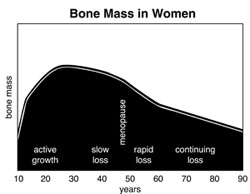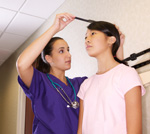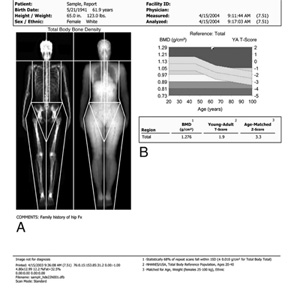
Healthy Bones at Every Age
This article is also available in Spanish: Huesos saludables en todas las edades (Healthy Bones at Every Age).
Bone health is important at every age and stage of life. The skeleton is our body's storage bank for calcium — a mineral that is necessary for our bodies to function. Calcium is especially important as a building block of bone tissue.
We must get calcium from the foods we eat. If we do not have enough calcium in our diets to keep our bodies functioning, calcium is removed from where it is stored in our bones. Over time, this causes our bones to grow weaker.
Loss of bone strength can lead to osteoporosis — a disorder in which bones become very fragile and more likely to break. Older adults with osteoporosis are most vulnerable to breaks in the wrist, hip, and spine. These fractures can seriously limit mobility and independence.
Fortunately, there are many things we can do at every age to keep our bones strong and healthy.
Peak Bone MassOur maximum bone size and strength is called peak bone mass. Genes play a large role in how much peak bone we have. For example, the actual size and structure of a person's skeleton is determined by genetic factors.
 Between the ages of 10 and 20 we can greatly increase our peak bone mass with a calcium-rich diet and regular weightbearing exercise.
© Thinkstock, 2012
Between the ages of 10 and 20 we can greatly increase our peak bone mass with a calcium-rich diet and regular weightbearing exercise.
© Thinkstock, 2012
Although peak bone mass is largely determined by our genes, there are lifestyle factors — such as diet and exercise — that can influence whether we reach our full bone mass potential.
There is a limited time that we can influence our peak bone mass. The best time to build bone density is during years of rapid growth. Childhood, adolescence, and early adulthood are the times when we can significantly increase our peak bone mass through diet and exercise. Not surprisingly, we can also make choices that decrease peak bone mass, such as smoking, poor nutrition, inactivity, and excessive alcohol intake.
Most people will reach their peak bone mass between the ages of 25 and 30. By the time we reach age 40, however, we slowly begin to lose bone mass. We can, however, take steps to avoid severe bone loss over time. For most of us, bone loss can be significantly slowed through proper nutrition and regular exercise.
Although everyone will lose bone with age, people who developed a higher peak bone mass when young are better protected against osteoporosis and related fractures later in life.
Some people, however, are at higher risk for bone loss and osteoporosis because of problems with the way their bodies remodel bone. A healthy diet and exercise can help, but bone will still be lost at a faster rate. The good news is that in recent years, medications have been developed to treat this metabolic problem. In severe cases, bone loss may even be reversed with newer, bone-forming medications.
Gender and Peak Bone Mass
Men have a higher peak bone mass than women. Men accumulate more skeletal mass than women do during growth, and their bone width and size is greater. Because women have smaller bones with a thinner cortex and smaller diameter, they are more vulnerable to developing osteoporosis. Although men have a higher peak bone mass, they also are at risk for osteoporosis, especially after age 70 when bone loss and fracture risk increases significantly.
 This chart shows bone mass in women as it relates to age.
Reproduced from J Bernstein, ed: Musculoskeletal Medicine. Rosemont, IL, American Academy of Orthopaedic Surgeons, 2003.
Bone Health at Every Stage
This chart shows bone mass in women as it relates to age.
Reproduced from J Bernstein, ed: Musculoskeletal Medicine. Rosemont, IL, American Academy of Orthopaedic Surgeons, 2003.
Bone Health at Every Stage
There are things we can do at every stage of life to ensure good bone health. Especially important is making sure we get enough calcium and Vitamin D. The sections below provide guidelines from the Food and Nutrition Board (FNB) at the Institute of Medicine of the National Academies on calcium and Vitamin D daily intake at every age for the general public.
Please note that some people may require different dosages of these supplements. For example, people who live in areas with little sun, those with darker skin, and people who are obese may need more Vitamin D than the recommended daily amount. The upper safe limit for people older than 9 years of daily Vitamin D is 4000 IU, but talk to your doctor about the best dose for you. Also, be aware that taking calcium and Vitamin D at higher than recommended levels may cause adverse side effects.
For a complete overview of calcium and Vitamin D Recommended Dietary Allowances (RDAs), as well as Tolerable Upper Intake Levels (ULs), refer to "Calcium, Nutrition, and Bone Health"
Birth to Age 9
Calcium is an essential mineral for babies and young children to ensure they are able to grow strong bones and teeth. Because our bodies need Vitamin D to absorb calcium from our diets, getting enough Vitamin D goes hand-in-hand with getting enough calcium. Young children who do not get enough Vitamin D are at risk for rickets, a disease that can cause bone weakness, bowed legs, and other skeletal deformities.
First year. According to the FNB, infants, age birth to 6 months, need 200 milligrams (mg) of calcium each day, and infants, ages 7 to 12 months, 260 mg. During this first year, both breast milk and infant formula provide sufficient calcium.
The FNB daily recommendation of Vitamin D for infants birth to 12 months is 400 International Units (IU). Although Vitamin D can be found in breast milk and infant formula, it is not in sufficient amounts. The American Academy of Pediatrics now recommends that babies take daily Vitamin D supplement drops, unless they are drinking 32 oz. of infant formula each day.
Ages 1 to 3 years. The amount of calcium and Vitamin D that a young child needs increases with age.
The FNB recommended dietary allowance (RDA) for children ages 1 to 3 are 700 mg of calcium and 600 IU of Vitamin D. Milk is one of the best sources of calcium for children — plus a cup of milk is fortified with 100 IU of Vitamin D. Doctors recommend whole milk for children between the ages of 1 and 2 years. Lowfat and skim milk are good options after age 2.
 The American Academy of Pediatrics recommends that all children take Vitamin D supplements.
© Thinkstock, 2012
The American Academy of Pediatrics recommends that all children take Vitamin D supplements.
© Thinkstock, 2012
Because very few foods contain substantial levels of Vitamin D, the American Academy of Pediatrics recommends that all children — from infancy through adolescence — take Vitamin D supplements.
Ages 4 to 8 years. Children ages 4 through 8 need 1,000 mg of calcium each day, or the equivalent of about two cups of yogurt and one glass of milk.
The FNB recommends 600 IU of Vitamin D for everyone from age 1 through 70 years. Recent research, however, supports that the body needs at least 1000 IU per day for good bone health, starting at age 5 years. Taking a Vitamin D supplement is the most effective way for your child to get 1000 IU of Vitamin D every day.
Between 10 and 20 Years of Age
This is the stage of life when peak bone mass is established.
Puberty. Puberty is a very important time in the development of the skeleton and peak bone mass. Half of total body calcium stores in women and up to 2/3 of calcium stores in men are made during puberty. At the end of puberty, men have about 50% more body calcium than women.
 Adolescents grow rapidly and need 1,300 mg of calcium each day for the best possiblle development of the skeleton.
© Thinkstock, 2012
Adolescents grow rapidly and need 1,300 mg of calcium each day for the best possiblle development of the skeleton.
© Thinkstock, 2012
On average, girls begin puberty at age 10 and start having menstrual periods about age 12. Having a regular period is important to girls' and women's bone health because it indicates that sufficient estrogen is being produced. Estrogen is a hormone that improves calcium absorption in the kidneys and intestines.
The average girl grows the fastest in height between the ages of 11 and 12 years, and stops growing between the ages of 14 and 15 years. About 95% of a young woman's peak bone mass is present by age 20, and some overall gains in mass often continue until age 30.
The average boy has his fastest rate of growth in height between ages 13 and 14, and stops growing between ages 17 and 18. Peak bone mass occurs 9 to 12 months after the peak rate in height growth.
Early or late onset of puberty affects peak bone mass. Boys with late puberty generally have less bone mass for life than those who start puberty at the typical time, about age 11 1/2. Obesity delays the start of puberty in boys and, therefore, may have a negative effect on peak bone mass.
Obesity in girls, however, accelerates the onset of puberty. The effect that obesity and early puberty have on the peak bone mass is variable in girls.
Nutrional requirements. Many adolescents and young adults do not get enough calcium. Both boys and girls age 10 to 20 years need at least 1,300 mg of calcium each day, the equivalent of:
- One cup of orange juice with added calcium
- Two cups of milk
- One cup of yogurt
Other dairy products, green leafy vegetables, fish, and tofu are also good sources of calcium.
A Vitamin D supplement is necessary to ensure the calcium that adolescents do take in is absorbed in the intestines. Sodas and carbonated beverages should be avoided for many nutritional reasons, including for bone health and to prevent obesity. Sodas decrease calcium absorption in the intestines and contain empty calories. Milk, calcium-fortified juices, and water are better beverage alternatives for all age groups.
Adolescent pregnancy. Like other adolescents, young women who are pregnant and/or breastfeeding between the ages of 14 and 18 should have 1300 mg of calcium each day. The RDA for Vitamin D remains 600 IU, although as mentioned above, recent research supports a daily dosage of 1000 IU for better bone health.
Exercise. Weightbearing exercise during the teen years is essential to reach maximum bone strength. Examples of weightbearing exercise include walking and running, as well as team sports like soccer and basketball.
Young women who exercise excessively can lose enough weight to cause hormonal changes that stop menstrual periods (amenorrhea). This loss of estrogen can cause bone loss at a time when young women should be adding to their peak bone mass. It is important to see a doctor if there have been any menstrual cycle changes or interruptions.
Between 20 and 30 Years of Age
Although your body is no longer forming new bone as readily as before, your bones will reach their peak strength during these years. It is important to get adequate calcium and exercise to help achieve peak bone density. Both men and women need at least 1,000 mg of calcium each day, and probably a Vitamin D supplement because it is difficult to get 1000 IU of Vitamin D even from a healthy diet.
To promote good bone health, adults need at least 30 minutes of weightbearing activity (such as a brisk walk), 4 or more days per week. Muscle-strengthening activities at least two days of the week are also recommended.
Pregnancy and breastfeeding. The calcium requirement for pregnant or breastfeeding women is the same for any adult in this age range: 1,000 mg. Of course, getting the recommended calcium and Vitamin D daily allowance is especially important when you are pregnant or breastfeeding. Without it, a growing baby in the womb may pull calcium out of the mother's bones in order to build its own skeleton. A nursing baby also requires calcium, and a mother can lose bone mass during the time she breastfeeds. In most cases, once breastfeeding ends, a healthy diet and exercise will help a mother regain any bone lost.
Between 30 and 50 Years of Age
After you reach your peak bone mass, you will begin to gradually lose bone. All through your life, your body is continually removing old bone and replacing it with fresh bone. This process is called remodeling. Up until about age 40, all the bone removed is replaced. After age 40, however, less bone is replaced. At this stage in life, getting enough exercise and calcium (1,000 mg) and Vitamin D (1,000 IU) every day, are crucial to minimizing bone loss. Exercise is also important for maintaining your muscle mass, which preserves and strengthens surrounding bone and helps prevent falls.
Older Than 50 Years of Age
The daily calcium recommendation for men over 50 remains the same at 1,000 mg. Many women over 50 are entering or have gone through menopause, and the FNB recommends that women over 50 increase their daily calcium intake to 1,200 mg.
Menopause. Most women enter menopause between the ages of 42 and 55. As the levels of estrogen drop dramatically, women undergo rapid bone loss. In fact, in the 10 years after menopause, women can lose 40% of their spongy, inner bone and 10% of their hard, outer bone. This reduces bone strength and increases a woman's risk for fracture. It also helps explain why osteoporosis is much more common in women than in men (who do not experience this acute loss of hormone in middle age).
In the past, estrogen replacement therapy was frequently used to protect aging women from bone loss. Research has since shown that there are significant risks in taking estrogen long-term after menopause. These include increased risk of serious blood clots, stroke, heart attack, breast and ovarian cancers, gall bladder disease, and possibly dementia.
If your period becomes irregular, or, if you develop signs of menopause, such as hot flashes, talk with your doctor. You also may want to ask about bone density testing. This is a safe, painless, x-ray technique that compares your current bone density with the peak bone mass someone your same gender and ethnicity should have reached at 20 to 25 years of age.
 A duel-energy x-ray absorptiometry (DXA) scan is the "gold standard" of bone mineral density testing.
Reproduced with permission from JF Sarwark, ed: Essentials of Musculoskeletal Care, ed 4. Rosemont, IL, American Academy of Orthopaedic Surgeons, 2010
A duel-energy x-ray absorptiometry (DXA) scan is the "gold standard" of bone mineral density testing.
Reproduced with permission from JF Sarwark, ed: Essentials of Musculoskeletal Care, ed 4. Rosemont, IL, American Academy of Orthopaedic Surgeons, 2010
Age 70 and above. Both men and women should get 1,200 mg of calcium each day. The RDA for Vitamin D at this age is 800 IU.
After they reach the age of 70, men are more likely to experience low bone mass and fractures. Men over age 70 should discuss bone density testing with a doctor.
Fall prevention becomes especially important for people over age 70. Falls are the leading cause of injury to elderly people in the United States. Falls cause many seniors to lose their independence, requiring a change in living arrangements, such as moving to a nursing home or assisted living facility. Fortunately, many falls can be prevented, and having strong bones can help prevent fractures.
No matter your age, adequate calcium intake and exercise can limit bone loss and increase bone and muscle strength.
Source: http://orthoinfo.aaos.org/topic.cfm?topic=A00127
